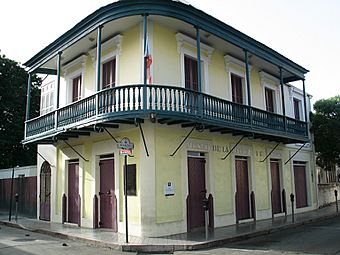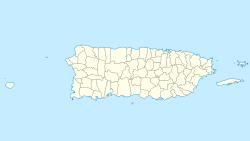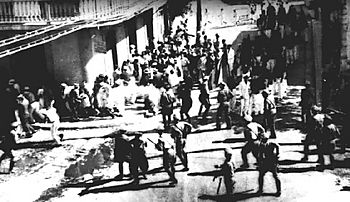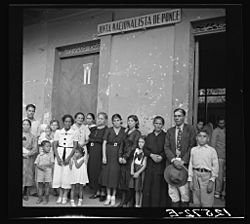Museo de la Masacre de Ponce facts for kids
Quick facts for kids |
|
|
Casa de la Masacre
|
|

The Ponce massacre building as a museum in 2010
|
|
| Location | SE corner of Marina and Aurora Streets (32 Marina St.), Ponce, Puerto Rico |
|---|---|
| Area | less than one acre |
| Built | 1910 |
| Architect | Blas Silva |
| Architectural style | Ponce Creole |
| NRHP reference No. | 05001098 |
| Added to NRHP | October 20, 2005 |
The Museo de la Masacre de Ponce (Ponce Massacre Museum) is a human rights museum and a historic building in Ponce, Puerto Rico. It tells the story of the Ponce massacre, a sad event that happened in 1937. The museum is located in the very building where the event took place.
One part of the museum is about Pedro Albizu Campos, a leader of the Puerto Rican Nationalist Party. The museum also shows how the United States kept a close watch on Puerto Rican Nationalists. It has many photos from that time. The museum is listed on the U.S. National Register of Historic Places as Casa de la Masacre (the Massacre House).
Contents
Understanding the Background
After the United States took control of Puerto Rico in 1898, people on the island began to discuss its future. Many political groups formed, each with different ideas about Puerto Rico's relationship with the U.S. Some wanted Puerto Rico to become a U.S. state. Others wanted it to be a commonwealth, which meant it would be connected to the U.S. but have its own government. A third group wanted complete independence. The Puerto Rican Nationalist Party became a symbol for those who wanted independence.
Governor Winship's Actions
In the early 1930s, more people in Puerto Rico supported independence. At this time, U.S. President Franklin D. Roosevelt appointed a new governor for the island. His name was Blanton Winship, and he was a former U.S. Army General.
Governor Winship chose E. Francis Riggs, a U.S. military officer, to be his Chief of Police. Winship was governor for five years, from 1934 to 1939. During this time, he openly opposed the Nationalist Party and its leaders. In October 1935, the police shot and killed four Nationalist Party members. This happened at the University of Puerto Rico in Rio Piedras. This event became known as the Río Piedras massacre.
According to a book about the Ponce Massacre Museum, the police killed these four men on purpose. They were acting under the orders of the U.S.-appointed police chief, Colonel Francis Riggs. In response, two young Nationalists killed Colonel Francis Riggs on February 23, 1936. These two Nationalists were caught and killed by police without a trial. No police officer was ever charged for their deaths.
Governor Winship was very angry about Riggs' death. He ordered police to search every Nationalist Party office on the island. He wanted to find proof that the party was involved in Riggs' killing. However, no evidence was ever found.
Even without proof, Winship's government accused Albizu Campos and other party leaders of trying to overthrow the government. A jury, mostly made up of Puerto Ricans, found them not guilty. But Governor Winship arranged for a new trial. This time, most of the jury members were from the United States. Albizu Campos was found guilty and sentenced to ten years in prison. Other leaders received six-year sentences. They were sent to a federal prison in Atlanta. However, putting the party leaders in prison did not stop the Nationalist movement. It also did not stop Winship's harsh actions. This led to the violent event in Ponce in 1937.
The Planned Parade
The Ponce branch of the Nationalist Party had its main office at 32 Marina Street. This building was on a corner, next to Aurora Street. The party had used this building for meetings for over 10 years. In 1937, the local committee planned to celebrate the anniversary of the abolition of slavery in Puerto Rico. Slavery had ended on March 22, 1873. The party chose March 21, 1937, for the 64th anniversary celebration.
The Nationalists had received permission for their parade from Ponce Mayor José Tormos Diego. The parade was set for Palm Sunday. But at the last minute, Governor Winship told the new police chief, Colonel Enrique de Orbeta, to cancel the parade permit. He also ordered more police to be sent to Ponce. Winship told Orbeta to stop any Nationalist demonstration in Ponce, "by any means necessary."
The Tragic Massacre
The permit was canceled on the very morning of the parade. But the Nationalist Party decided not to cancel the event. They told participants to gather as planned in front of their club house and continue with the activity. The group included male members of the Cadets of the Republic, female members of the "Daughters of the Republic," and a small music band. These groups, along with their families, friends, and local people watching, began to gather around the club house for the midday parade. At the same time, about 150 well-armed police officers surrounded the demonstrators.
Tomás López de Victoria, the Cadet Captain of Ponce, was in charge of the Cadets. Moments before the march began, police Captain Soldevilla told López de Victoria to stop the Cadets from marching. López de Victoria then ordered the cadet band to play La Borinqueña, which is the Puerto Rican national anthem. He told his Cadets to start their march.
It is believed that a shot was fired by the police to start an incident. This would give them an excuse to open fire on the unarmed marchers. The police then fired many shots into the crowd. Fifteen to twenty policemen used machine guns for ten minutes. This wounded almost 200 people and immediately killed fourteen. Five more people died from their injuries in the following days.
The Investigation that Followed
The violent event in Ponce shocked everyone on the island, no matter their political views. The American Civil Liberties Union (ACLU) came to Puerto Rico. They formed a group of respected citizens to investigate what happened. Dr. Arthur Garfield Hays, the President of the ACLU, led this group. After months of investigation, the ACLU group concluded that Governor Winship was directly responsible for the incident. They also found that the Nationalists were simply using their basic rights of freedom of speech and assembly. The killing of unarmed party members and bystanders was called a "massacre." The afternoon of March 21, 1937, became one of the saddest and most violent days in Puerto Rico's fight for independence.
The Historic Building
Building Construction Details
The Ponce Massacre Museum is a two-story house. It is located at the corner of Marina and Aurora streets, where the tragic events took place. The building is made of brick and wood. Records from the Municipality of Ponce show a house at this spot as early as 1886. However, the current building, which the Nationalist Party used, was built in the early 1900s.
Around 1906, the owners hired Blas Silva, a famous civil engineer from Ponce. He designed new outside walls and inside rooms for the property. The changes were finished in 1910. However, only some parts of Blas Silva's design were used.
How the Museum Developed
At the time of the 1937 Ponce massacre, the owners were Francisco de Jesus and Graciela Toro Vendrell. In 1945, the property was sold to Juan Riera Ginard and Carmen M. Toro de Riera. They never lived in the house. Instead, they rented it out. The first floor was rented as a business space, and the second floor was a home.
In 1987, the Puerto Rico Legislature passed a special law. This law made the property a national historic landmark. In 1988, the Institute of Puerto Rican Culture bought the building. They fixed it up and turned it into the Museo de la Masacre de Ponce. The building's style is called Vernacular Creole.
Renovation and Re-opening
The museum closed temporarily in 2006 for repairs and restoration. After a $275,000 renovation, the museum re-opened in 2013.
Impact of the 2020 Earthquake
The building was damaged by the 2020 Puerto Rico earthquake.
See also
 In Spanish: Museo de la Masacre de Ponce para niños
In Spanish: Museo de la Masacre de Ponce para niños





